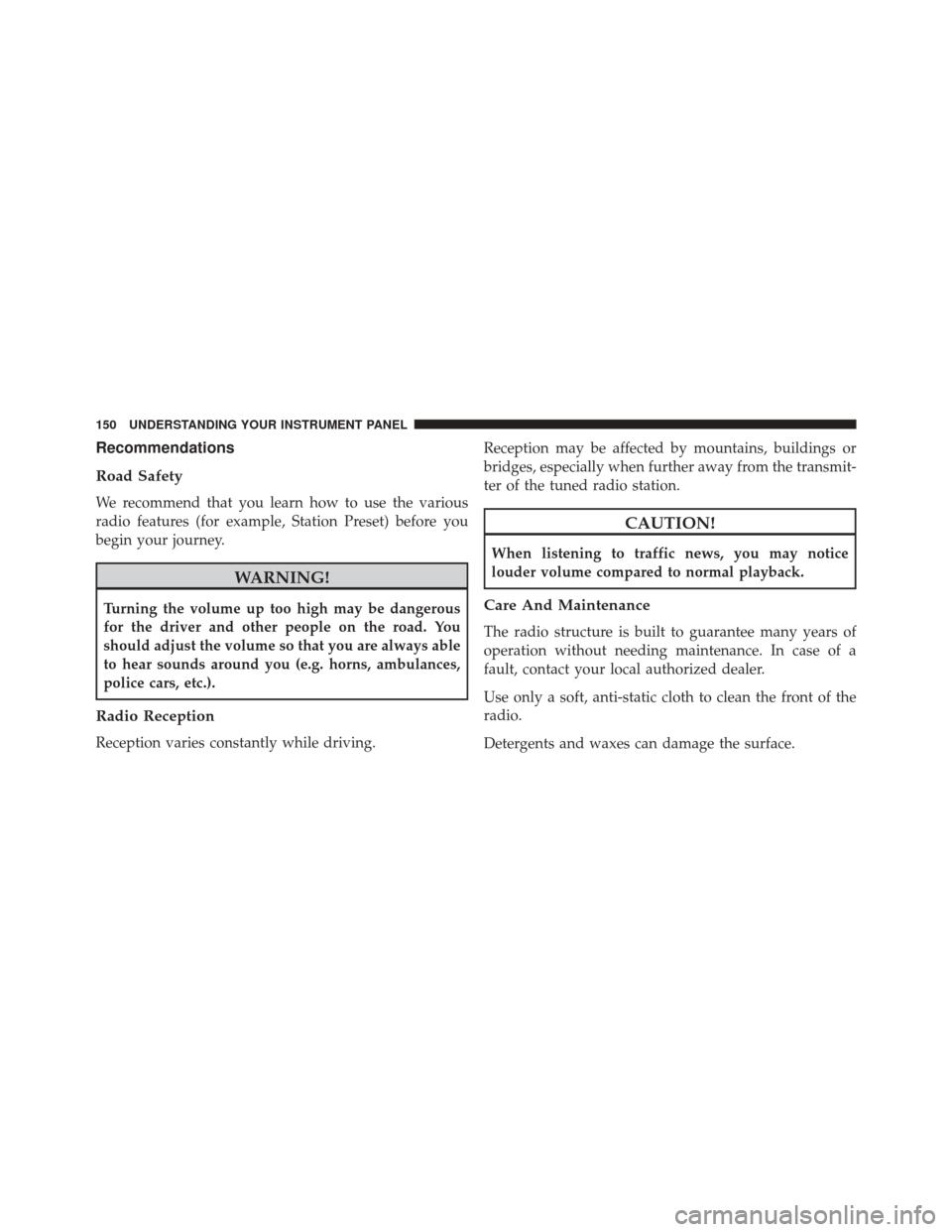Page 17 of 425

•This device must accept any interference that may be
received, including interference that may cause unde-
sired operation.
NOTE: Changes or modifications not expressly approved
by the party responsible for compliance could void the
user’s authority to operate the equipment.
VEHICLE SECURITY ALARM — IF EQUIPPED
The Vehicle Security Alarm monitors the vehicle doors
and ignition for unauthorized operation. When the Ve-
hicle Security Alarm is activated, interior switches for
door locks are disabled. The system provides both au-
dible and visible signals. For the first three minutes, the
horn will sound, and the turn signal lights will flash. For
an additional 15 minutes, only the turn signal lights will
flash.
Rearming Of The System
If the system has not been disabled, the Vehicle Security
Alarm will rearm itself after the 15 additional minutes of
turn lamps flashing. If the condition which initiated the
alarm is still present, the system will ignore that condi-
tion and monitor the remaining doors and ignition.
To Arm The System
To arm the system, The Vehicle Security Alarm will set
when you use the Remote Keyless Entry (RKE) transmit-
ter to lock the doors. If a door or the hood is not properly
shut, the alarm system will not be armed.
To Disarm The System
Use the RKE transmitter to unlock the door and disarm
the system.
2
THINGS TO KNOW BEFORE STARTING YOUR VEHICLE 15
Page 20 of 425

To Unlock The Doors
Push and release the UNLOCK button on RKE transmit-
ter once to unlock only the front doors. Push and release
the CARGO UNLOCK button on RKE transmitter once to
unlock the cargo area (rear lateral sliding doors and rear
door). The turn signal lights will flash to acknowledge
the unlock signal.
To Lock The Doors
Push and release the LOCK button on the RKE transmit-
ter to lock all doors. The turn signal lights will flash to
acknowledge the signal; the horn will chirp too during
turn signal lights flashing.
If a door is ajar, the turn signal lights will flash at an
increased rate, and there will be no horn chirp. This is to
indicate that a door is still ajar.
Programming Additional Transmitters
Refer to “Sentry Key®” in “Things To Know Before
Starting” for further information.
If you do not have a programmed RKE transmitter,
contact your authorized dealer for details.
Transmitter Battery Replacement
NOTE:Perchlorate Material – special handling may ap-
ply. See www.dtsc.ca.gov/hazardouswaste/perchlorate
The recommended replacement battery is CR2032.
1. Push the mechanical key release button and release the mechanical key to access the battery case screw lo-
cated on the side of the Key Fob.
2. Rotate the screw located on the side of the Key Fob using a small screwdriver.
18 THINGS TO KNOW BEFORE STARTING YOUR VEHICLE
Page 128 of 425
INSTRUMENT PANEL FEATURES
1 — Air Outlet10 — Lower Glove Compartment 19 — Uconnect® Phone Buttons
2 — Multifunction Lever (External Lights) 11 — Cup Holder20 — Tilt Steering Column Release Lever
3 — Instrument Cluster 12 — USB Charger/12V21 — Horn
4 — Multifunction Lever (Front/Rear Wiper, Trip Computer) 13 — Climate Controls 22 — Mute/Uconnect® Voice Command Buttons
5 — Radio 14 — Lower Switch Ban23 — Cruise Control Switches
6 — Clip Board 15 — Cup Holders24 — Fuse Box Lid
7 — Upper Glove Compartment 16 — Shift Lever25 — Electronic Vehicle information Center (EVIC)
Controls
8 — Passenger Air Bag
17 — USB / AUX
26 — Hood Release
9 — Storage Compartment
18 — Ignition Switch
126 UNDERSTANDING YOUR INSTRUMENT PANEL
Page 152 of 425

Recommendations
Road Safety
We recommend that you learn how to use the various
radio features (for example, Station Preset) before you
begin your journey.
WARNING!
Turning the volume up too high may be dangerous
for the driver and other people on the road. You
should adjust the volume so that you are always able
to hear sounds around you (e.g. horns, ambulances,
police cars, etc.).
Radio Reception
Reception varies constantly while driving.Reception may be affected by mountains, buildings or
bridges, especially when further away from the transmit-
ter of the tuned radio station.
CAUTION!
When listening to traffic news, you may notice
louder volume compared to normal playback.
Care And Maintenance
The radio structure is built to guarantee many years of
operation without needing maintenance. In case of a
fault, contact your local authorized dealer.
Use only a soft, anti-static cloth to clean the front of the
radio.
Detergents and waxes can damage the surface.
150 UNDERSTANDING YOUR INSTRUMENT PANEL
Page 367 of 425
CavityMaxi Fuse Mini Fuse Description
F07 50 Amp Red (non
A/C)
60 Amp Blue (A/C) Engine Cooling Fan - 1st Speed
F08 40 Amp Orange Passenger Compartment Blower
F09 15 Amp Blue Rear Power Outlet
F10 15 Amp Blue Horn
F11 15 Amp Blue Fuel Pressure Regulator (MPROP)-DRV
(3.0 Diesel Engine) — If Equipped
F14 20 Amp Yellow Power Outlet
F15 7.5 Amp Brown USB Charger
F16 7.5 Amp Brown KL15 Shifter Transmission Module
(STM) (3.6), KL15 Starter Relay Coil (3.6
Gasoline Engine)
7
MAINTAINING YOUR VEHICLE 365